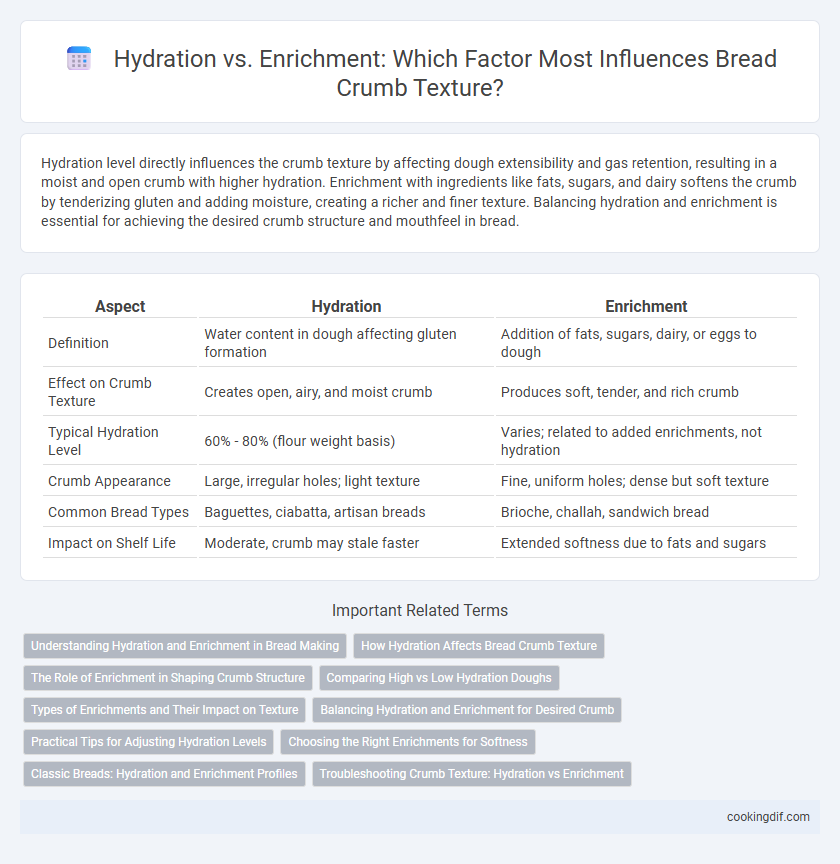Hydration level directly influences the crumb texture by affecting dough extensibility and gas retention, resulting in a moist and open crumb with higher hydration. Enrichment with ingredients like fats, sugars, and dairy softens the crumb by tenderizing gluten and adding moisture, creating a richer and finer texture. Balancing hydration and enrichment is essential for achieving the desired crumb structure and mouthfeel in bread.
Table of Comparison
| Aspect | Hydration | Enrichment |
|---|---|---|
| Definition | Water content in dough affecting gluten formation | Addition of fats, sugars, dairy, or eggs to dough |
| Effect on Crumb Texture | Creates open, airy, and moist crumb | Produces soft, tender, and rich crumb |
| Typical Hydration Level | 60% - 80% (flour weight basis) | Varies; related to added enrichments, not hydration |
| Crumb Appearance | Large, irregular holes; light texture | Fine, uniform holes; dense but soft texture |
| Common Bread Types | Baguettes, ciabatta, artisan breads | Brioche, challah, sandwich bread |
| Impact on Shelf Life | Moderate, crumb may stale faster | Extended softness due to fats and sugars |
Understanding Hydration and Enrichment in Bread Making
Hydration levels directly impact crumb texture by influencing gluten development and dough elasticity, with higher hydration producing a more open and airy crumb. Enrichment through ingredients like butter, milk, and eggs contributes to softness, moisture retention, and richness, resulting in a tender, fine crumb structure. Balancing hydration and enrichment is essential for achieving the desired crumb texture, whether aiming for crusty artisan loaves or soft sandwich bread.
How Hydration Affects Bread Crumb Texture
Hydration levels directly influence bread crumb texture by affecting gluten development and gas retention during fermentation. Higher hydration creates a more open, airy crumb with larger holes, ideal for artisan and ciabatta breads. Lower hydration produces a denser, tighter crumb structure typical of sandwich breads and bagels.
The Role of Enrichment in Shaping Crumb Structure
Enrichment ingredients such as fats, sugars, and dairy significantly influence crumb structure by tenderizing the dough and promoting a finer, softer texture. These components interfere with gluten development, leading to a more open and moist crumb compared to high-hydration doughs that rely primarily on water content for extensibility. Enriched doughs typically yield a richer mouthfeel and improved shelf life, distinguishing them from lean, high-hydration breads.
Comparing High vs Low Hydration Doughs
High hydration doughs, containing 70% or more water relative to flour weight, create open, airy crumb textures with large irregular holes ideal for artisan bread like ciabatta and sourdough. Low hydration doughs, with around 50-60% water, produce denser, tighter crumbs typical of enriched breads such as brioche and challah, where fats and sugars enhance softness and richness. Compared to enrichment, hydration levels primarily influence gluten development and gas retention, directly affecting crumb openness and chewiness in bread.
Types of Enrichments and Their Impact on Texture
Types of enrichments such as butter, eggs, milk, and sugar significantly influence crumb texture by increasing tenderness, moisture, and richness. Butter adds fat that coats gluten strands, resulting in a softer and finer crumb, while eggs contribute proteins and emulsifiers that improve structure and chewiness. Milk provides lactose and fats that enhance browning and moistness, whereas sugar retains moisture and extends softness, creating a more delicate and enriched crumb compared to high hydration doughs.
Balancing Hydration and Enrichment for Desired Crumb
Balancing hydration and enrichment is crucial for achieving the desired crumb texture in bread, as higher hydration levels create an open, airy crumb while increased enrichment contributes to a tender, moist interior. Optimal hydration typically ranges from 60% to 75%, depending on flour type and bread style, while enrichment ingredients like butter, milk, or eggs enhance softness and richness. Adjusting these variables carefully ensures a crumb that meets specific texture preferences, from chewy artisan loaves to soft sandwich breads.
Practical Tips for Adjusting Hydration Levels
Adjusting hydration levels in bread dough significantly impacts crumb texture by controlling moisture content and gluten development. Increasing hydration results in a more open, airy crumb with larger holes, while reducing hydration produces a denser, tighter crumb ideal for sandwich bread. Practical tips include gradually adding water during mixing, monitoring dough stickiness, and adjusting flour types to balance absorption for consistent crumb quality.
Choosing the Right Enrichments for Softness
Selecting enrichments such as fats, dairy, and sugars significantly influences bread crumb softness by retaining moisture and tenderizing the dough structure. Higher hydration levels improve crumb openness but combining them with enrichments like butter or milk creates a finer, more tender crumb texture. Optimal softness results from balancing hydration with enriching ingredients that enhance moisture retention and cell structure in the bread.
Classic Breads: Hydration and Enrichment Profiles
Classic breads achieve ideal crumb texture through a balance of hydration and enrichment: hydration levels typically range from 60% to 75%, influencing crumb openness and chewiness, while enrichment with fats, sugars, or dairy enhances softness and flavor complexity. Lower hydration yields denser, tighter crumbs, whereas higher hydration produces lighter, airy structures characteristic of artisanal breads. Enrichment ingredients like butter, milk, and eggs contribute to a tender crumb by interfering with gluten development and retaining moisture.
Troubleshooting Crumb Texture: Hydration vs Enrichment
Troubleshooting crumb texture in bread involves balancing hydration and enrichment levels, where higher hydration generally creates a more open, airy crumb due to increased water content aiding gluten development and gas retention. Enrichment ingredients like fats, sugars, and dairy can densify the crumb by interfering with gluten network formation and moisture absorption, leading to a softer but sometimes tighter texture. Adjusting hydration upwards while moderating enrichment can resolve issues of a dense or gummy crumb, optimizing softness without sacrificing openness.
Hydration vs Enrichment for crumb texture Infographic

 cookingdif.com
cookingdif.com